Clinical Leadership and Management
VerifiedAdded on 2023/01/10
|10
|2919
|37
AI Summary
This document discusses a case of failure to exhibit cultural competence and deliver culturally safe care to a patient. It explores the measures taken to mitigate the situation, the leadership style employed, and the impact on patient and staff outcomes.
Contribute Materials
Your contribution can guide someone’s learning journey. Share your
documents today.
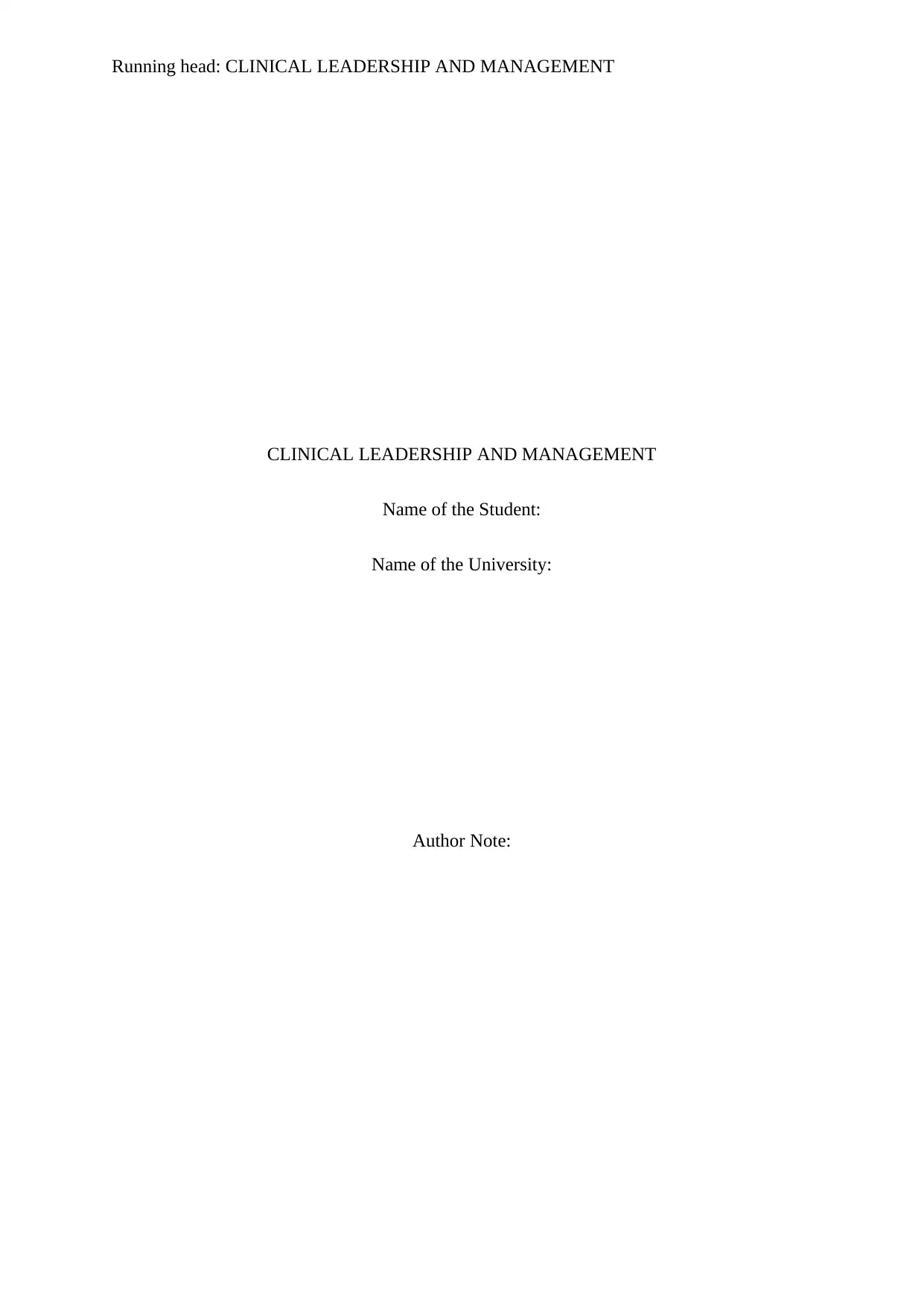
Running head: CLINICAL LEADERSHIP AND MANAGEMENT
CLINICAL LEADERSHIP AND MANAGEMENT
Name of the Student:
Name of the University:
Author Note:
CLINICAL LEADERSHIP AND MANAGEMENT
Name of the Student:
Name of the University:
Author Note:
Secure Best Marks with AI Grader
Need help grading? Try our AI Grader for instant feedback on your assignments.
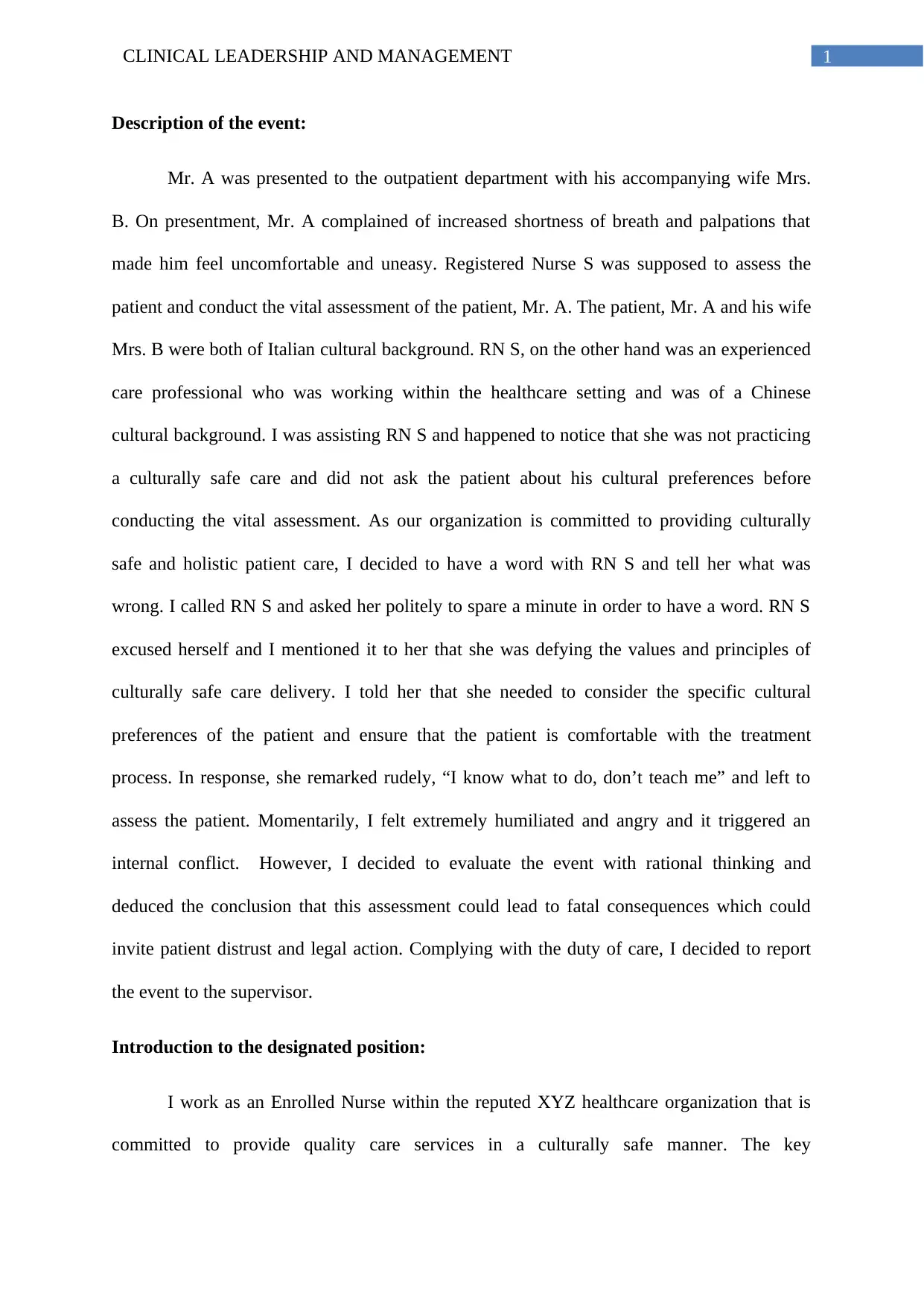
1CLINICAL LEADERSHIP AND MANAGEMENT
Description of the event:
Mr. A was presented to the outpatient department with his accompanying wife Mrs.
B. On presentment, Mr. A complained of increased shortness of breath and palpations that
made him feel uncomfortable and uneasy. Registered Nurse S was supposed to assess the
patient and conduct the vital assessment of the patient, Mr. A. The patient, Mr. A and his wife
Mrs. B were both of Italian cultural background. RN S, on the other hand was an experienced
care professional who was working within the healthcare setting and was of a Chinese
cultural background. I was assisting RN S and happened to notice that she was not practicing
a culturally safe care and did not ask the patient about his cultural preferences before
conducting the vital assessment. As our organization is committed to providing culturally
safe and holistic patient care, I decided to have a word with RN S and tell her what was
wrong. I called RN S and asked her politely to spare a minute in order to have a word. RN S
excused herself and I mentioned it to her that she was defying the values and principles of
culturally safe care delivery. I told her that she needed to consider the specific cultural
preferences of the patient and ensure that the patient is comfortable with the treatment
process. In response, she remarked rudely, “I know what to do, don’t teach me” and left to
assess the patient. Momentarily, I felt extremely humiliated and angry and it triggered an
internal conflict. However, I decided to evaluate the event with rational thinking and
deduced the conclusion that this assessment could lead to fatal consequences which could
invite patient distrust and legal action. Complying with the duty of care, I decided to report
the event to the supervisor.
Introduction to the designated position:
I work as an Enrolled Nurse within the reputed XYZ healthcare organization that is
committed to provide quality care services in a culturally safe manner. The key
Description of the event:
Mr. A was presented to the outpatient department with his accompanying wife Mrs.
B. On presentment, Mr. A complained of increased shortness of breath and palpations that
made him feel uncomfortable and uneasy. Registered Nurse S was supposed to assess the
patient and conduct the vital assessment of the patient, Mr. A. The patient, Mr. A and his wife
Mrs. B were both of Italian cultural background. RN S, on the other hand was an experienced
care professional who was working within the healthcare setting and was of a Chinese
cultural background. I was assisting RN S and happened to notice that she was not practicing
a culturally safe care and did not ask the patient about his cultural preferences before
conducting the vital assessment. As our organization is committed to providing culturally
safe and holistic patient care, I decided to have a word with RN S and tell her what was
wrong. I called RN S and asked her politely to spare a minute in order to have a word. RN S
excused herself and I mentioned it to her that she was defying the values and principles of
culturally safe care delivery. I told her that she needed to consider the specific cultural
preferences of the patient and ensure that the patient is comfortable with the treatment
process. In response, she remarked rudely, “I know what to do, don’t teach me” and left to
assess the patient. Momentarily, I felt extremely humiliated and angry and it triggered an
internal conflict. However, I decided to evaluate the event with rational thinking and
deduced the conclusion that this assessment could lead to fatal consequences which could
invite patient distrust and legal action. Complying with the duty of care, I decided to report
the event to the supervisor.
Introduction to the designated position:
I work as an Enrolled Nurse within the reputed XYZ healthcare organization that is
committed to provide quality care services in a culturally safe manner. The key

2CLINICAL LEADERSHIP AND MANAGEMENT
responsibilities that I am entitled to cover comprises of assisting registered nurses and
patients as and when required and address other activities such as administering medication,
documenting measurements, cleaning wounds, changing dressings, calibrating medical
instruments and assist in patients with activities of daily living such as walking, bathing and
eating. In addition to this, as an Enrolled Nurse I am also entitled to comply with the
protocols of effective patient care and ensure that a positive, caring and patient-friendly care
environment is reinforced within the healthcare setting so as to promote positive outcome. In
addition to this, my key responsibilities also include recording and documenting patient’s
assessment and update the patient-database with the latest information. In this case, I
accompanied RN S while she was assessing Mr. A and it was during the procedure of the
vital assessment that I noticed RN S was not exhibiting cultural competency and delivering a
culturally safe care to the patient. The first solution I could think of was to directly
communicate with RN S and point out the issue. I did the same as per my best understanding
and complying with the duty of care but the outcome was not in favour of the patient. It was
then that I decided to take a step further and escalate the event and bring it to the notice of the
supervisor.
Measures applied for mitigating the situation:
As has already been mentioned in the previous sections, on sensing that direct
communication did not have a positive impact on the event, I escalated the issue to the
supervisor adhering to the principles of the line of reporting. The supervisor called for a one
on one meeting where RN S was asked about the event and was asked to show cause for her
failure to comply with the professional standards of Nursing Practice. Initially, RN S denied
that such an incident took place and at that moment. I was then called to provide a testimony
of the situation. I narrated the incident honestly and it was then that RN S accepted her fault.
The supervisor penalised RN S and referred her to a one week refreshment training course so
responsibilities that I am entitled to cover comprises of assisting registered nurses and
patients as and when required and address other activities such as administering medication,
documenting measurements, cleaning wounds, changing dressings, calibrating medical
instruments and assist in patients with activities of daily living such as walking, bathing and
eating. In addition to this, as an Enrolled Nurse I am also entitled to comply with the
protocols of effective patient care and ensure that a positive, caring and patient-friendly care
environment is reinforced within the healthcare setting so as to promote positive outcome. In
addition to this, my key responsibilities also include recording and documenting patient’s
assessment and update the patient-database with the latest information. In this case, I
accompanied RN S while she was assessing Mr. A and it was during the procedure of the
vital assessment that I noticed RN S was not exhibiting cultural competency and delivering a
culturally safe care to the patient. The first solution I could think of was to directly
communicate with RN S and point out the issue. I did the same as per my best understanding
and complying with the duty of care but the outcome was not in favour of the patient. It was
then that I decided to take a step further and escalate the event and bring it to the notice of the
supervisor.
Measures applied for mitigating the situation:
As has already been mentioned in the previous sections, on sensing that direct
communication did not have a positive impact on the event, I escalated the issue to the
supervisor adhering to the principles of the line of reporting. The supervisor called for a one
on one meeting where RN S was asked about the event and was asked to show cause for her
failure to comply with the professional standards of Nursing Practice. Initially, RN S denied
that such an incident took place and at that moment. I was then called to provide a testimony
of the situation. I narrated the incident honestly and it was then that RN S accepted her fault.
The supervisor penalised RN S and referred her to a one week refreshment training course so
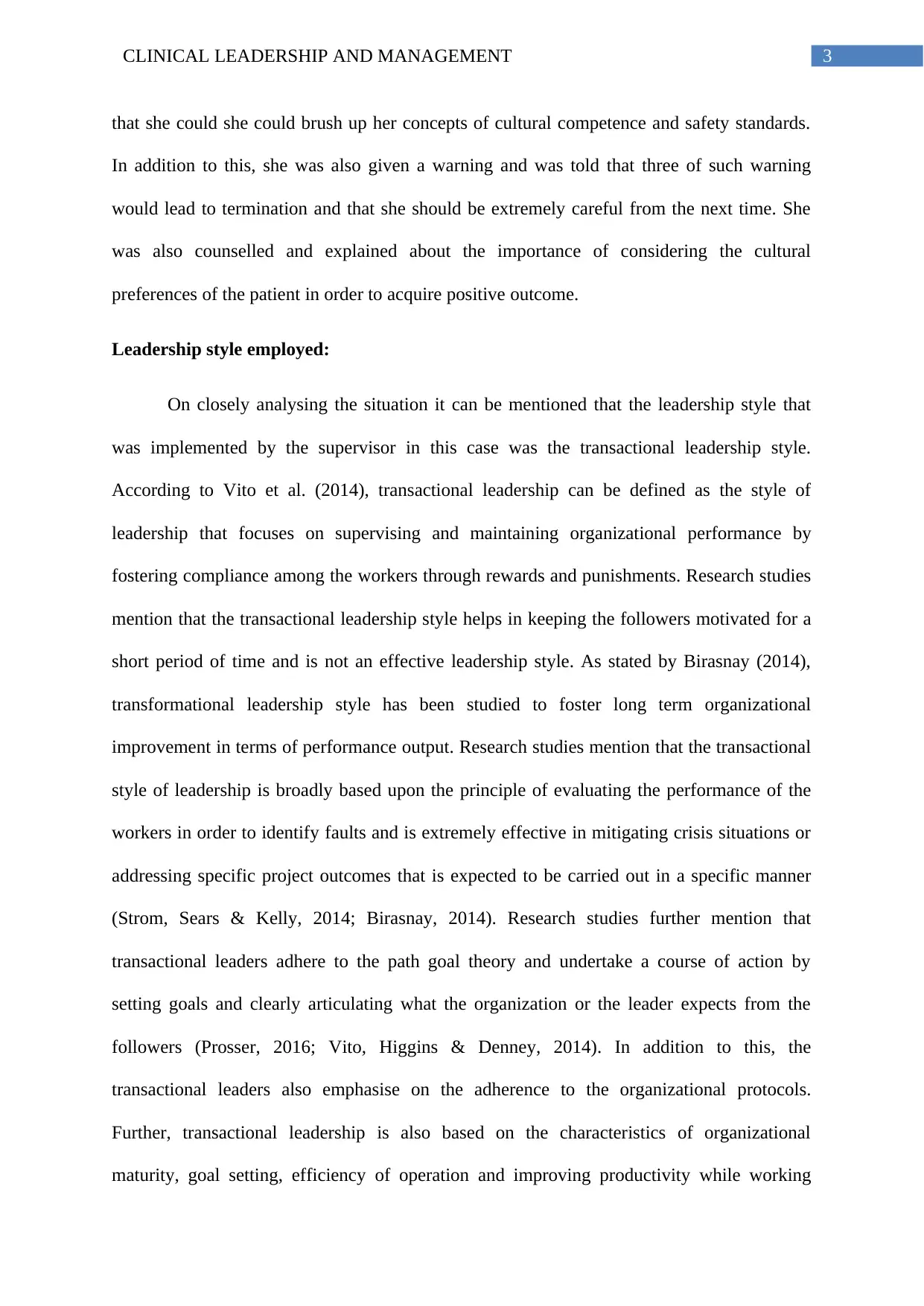
3CLINICAL LEADERSHIP AND MANAGEMENT
that she could she could brush up her concepts of cultural competence and safety standards.
In addition to this, she was also given a warning and was told that three of such warning
would lead to termination and that she should be extremely careful from the next time. She
was also counselled and explained about the importance of considering the cultural
preferences of the patient in order to acquire positive outcome.
Leadership style employed:
On closely analysing the situation it can be mentioned that the leadership style that
was implemented by the supervisor in this case was the transactional leadership style.
According to Vito et al. (2014), transactional leadership can be defined as the style of
leadership that focuses on supervising and maintaining organizational performance by
fostering compliance among the workers through rewards and punishments. Research studies
mention that the transactional leadership style helps in keeping the followers motivated for a
short period of time and is not an effective leadership style. As stated by Birasnay (2014),
transformational leadership style has been studied to foster long term organizational
improvement in terms of performance output. Research studies mention that the transactional
style of leadership is broadly based upon the principle of evaluating the performance of the
workers in order to identify faults and is extremely effective in mitigating crisis situations or
addressing specific project outcomes that is expected to be carried out in a specific manner
(Strom, Sears & Kelly, 2014; Birasnay, 2014). Research studies further mention that
transactional leaders adhere to the path goal theory and undertake a course of action by
setting goals and clearly articulating what the organization or the leader expects from the
followers (Prosser, 2016; Vito, Higgins & Denney, 2014). In addition to this, the
transactional leaders also emphasise on the adherence to the organizational protocols.
Further, transactional leadership is also based on the characteristics of organizational
maturity, goal setting, efficiency of operation and improving productivity while working
that she could she could brush up her concepts of cultural competence and safety standards.
In addition to this, she was also given a warning and was told that three of such warning
would lead to termination and that she should be extremely careful from the next time. She
was also counselled and explained about the importance of considering the cultural
preferences of the patient in order to acquire positive outcome.
Leadership style employed:
On closely analysing the situation it can be mentioned that the leadership style that
was implemented by the supervisor in this case was the transactional leadership style.
According to Vito et al. (2014), transactional leadership can be defined as the style of
leadership that focuses on supervising and maintaining organizational performance by
fostering compliance among the workers through rewards and punishments. Research studies
mention that the transactional leadership style helps in keeping the followers motivated for a
short period of time and is not an effective leadership style. As stated by Birasnay (2014),
transformational leadership style has been studied to foster long term organizational
improvement in terms of performance output. Research studies mention that the transactional
style of leadership is broadly based upon the principle of evaluating the performance of the
workers in order to identify faults and is extremely effective in mitigating crisis situations or
addressing specific project outcomes that is expected to be carried out in a specific manner
(Strom, Sears & Kelly, 2014; Birasnay, 2014). Research studies further mention that
transactional leaders adhere to the path goal theory and undertake a course of action by
setting goals and clearly articulating what the organization or the leader expects from the
followers (Prosser, 2016; Vito, Higgins & Denney, 2014). In addition to this, the
transactional leaders also emphasise on the adherence to the organizational protocols.
Further, transactional leadership is also based on the characteristics of organizational
maturity, goal setting, efficiency of operation and improving productivity while working
Secure Best Marks with AI Grader
Need help grading? Try our AI Grader for instant feedback on your assignments.
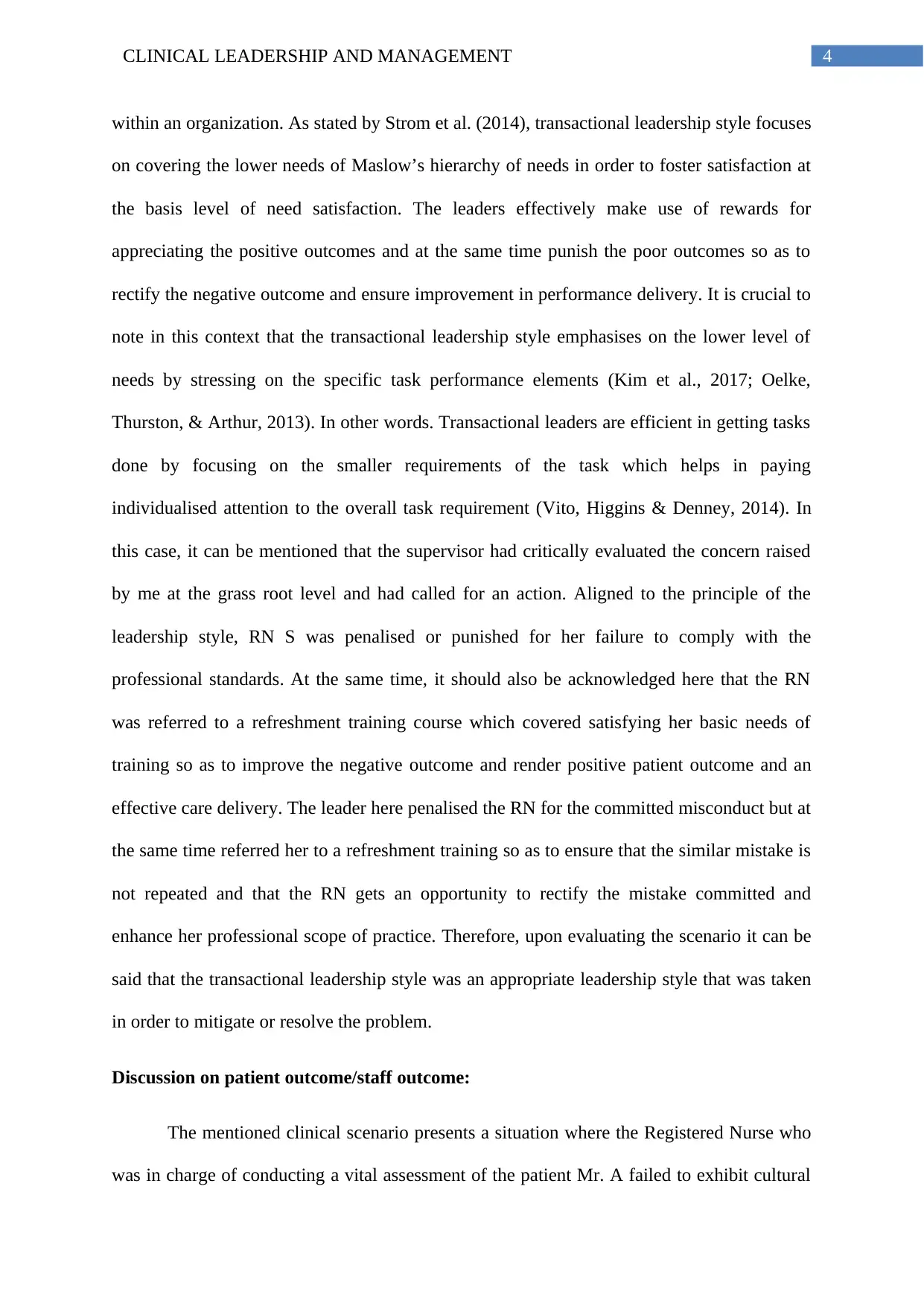
4CLINICAL LEADERSHIP AND MANAGEMENT
within an organization. As stated by Strom et al. (2014), transactional leadership style focuses
on covering the lower needs of Maslow’s hierarchy of needs in order to foster satisfaction at
the basis level of need satisfaction. The leaders effectively make use of rewards for
appreciating the positive outcomes and at the same time punish the poor outcomes so as to
rectify the negative outcome and ensure improvement in performance delivery. It is crucial to
note in this context that the transactional leadership style emphasises on the lower level of
needs by stressing on the specific task performance elements (Kim et al., 2017; Oelke,
Thurston, & Arthur, 2013). In other words. Transactional leaders are efficient in getting tasks
done by focusing on the smaller requirements of the task which helps in paying
individualised attention to the overall task requirement (Vito, Higgins & Denney, 2014). In
this case, it can be mentioned that the supervisor had critically evaluated the concern raised
by me at the grass root level and had called for an action. Aligned to the principle of the
leadership style, RN S was penalised or punished for her failure to comply with the
professional standards. At the same time, it should also be acknowledged here that the RN
was referred to a refreshment training course which covered satisfying her basic needs of
training so as to improve the negative outcome and render positive patient outcome and an
effective care delivery. The leader here penalised the RN for the committed misconduct but at
the same time referred her to a refreshment training so as to ensure that the similar mistake is
not repeated and that the RN gets an opportunity to rectify the mistake committed and
enhance her professional scope of practice. Therefore, upon evaluating the scenario it can be
said that the transactional leadership style was an appropriate leadership style that was taken
in order to mitigate or resolve the problem.
Discussion on patient outcome/staff outcome:
The mentioned clinical scenario presents a situation where the Registered Nurse who
was in charge of conducting a vital assessment of the patient Mr. A failed to exhibit cultural
within an organization. As stated by Strom et al. (2014), transactional leadership style focuses
on covering the lower needs of Maslow’s hierarchy of needs in order to foster satisfaction at
the basis level of need satisfaction. The leaders effectively make use of rewards for
appreciating the positive outcomes and at the same time punish the poor outcomes so as to
rectify the negative outcome and ensure improvement in performance delivery. It is crucial to
note in this context that the transactional leadership style emphasises on the lower level of
needs by stressing on the specific task performance elements (Kim et al., 2017; Oelke,
Thurston, & Arthur, 2013). In other words. Transactional leaders are efficient in getting tasks
done by focusing on the smaller requirements of the task which helps in paying
individualised attention to the overall task requirement (Vito, Higgins & Denney, 2014). In
this case, it can be mentioned that the supervisor had critically evaluated the concern raised
by me at the grass root level and had called for an action. Aligned to the principle of the
leadership style, RN S was penalised or punished for her failure to comply with the
professional standards. At the same time, it should also be acknowledged here that the RN
was referred to a refreshment training course which covered satisfying her basic needs of
training so as to improve the negative outcome and render positive patient outcome and an
effective care delivery. The leader here penalised the RN for the committed misconduct but at
the same time referred her to a refreshment training so as to ensure that the similar mistake is
not repeated and that the RN gets an opportunity to rectify the mistake committed and
enhance her professional scope of practice. Therefore, upon evaluating the scenario it can be
said that the transactional leadership style was an appropriate leadership style that was taken
in order to mitigate or resolve the problem.
Discussion on patient outcome/staff outcome:
The mentioned clinical scenario presents a situation where the Registered Nurse who
was in charge of conducting a vital assessment of the patient Mr. A failed to exhibit cultural
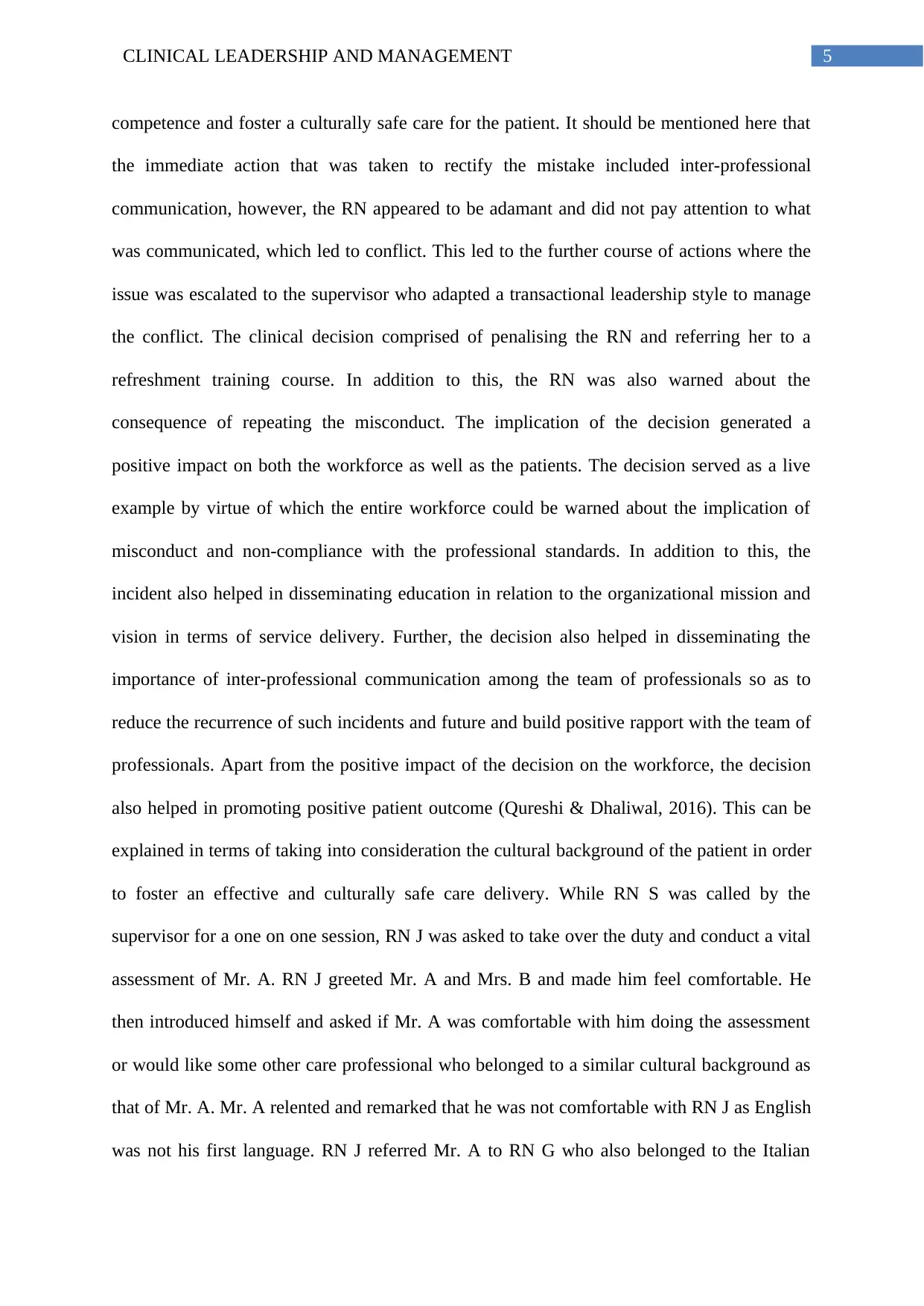
5CLINICAL LEADERSHIP AND MANAGEMENT
competence and foster a culturally safe care for the patient. It should be mentioned here that
the immediate action that was taken to rectify the mistake included inter-professional
communication, however, the RN appeared to be adamant and did not pay attention to what
was communicated, which led to conflict. This led to the further course of actions where the
issue was escalated to the supervisor who adapted a transactional leadership style to manage
the conflict. The clinical decision comprised of penalising the RN and referring her to a
refreshment training course. In addition to this, the RN was also warned about the
consequence of repeating the misconduct. The implication of the decision generated a
positive impact on both the workforce as well as the patients. The decision served as a live
example by virtue of which the entire workforce could be warned about the implication of
misconduct and non-compliance with the professional standards. In addition to this, the
incident also helped in disseminating education in relation to the organizational mission and
vision in terms of service delivery. Further, the decision also helped in disseminating the
importance of inter-professional communication among the team of professionals so as to
reduce the recurrence of such incidents and future and build positive rapport with the team of
professionals. Apart from the positive impact of the decision on the workforce, the decision
also helped in promoting positive patient outcome (Qureshi & Dhaliwal, 2016). This can be
explained in terms of taking into consideration the cultural background of the patient in order
to foster an effective and culturally safe care delivery. While RN S was called by the
supervisor for a one on one session, RN J was asked to take over the duty and conduct a vital
assessment of Mr. A. RN J greeted Mr. A and Mrs. B and made him feel comfortable. He
then introduced himself and asked if Mr. A was comfortable with him doing the assessment
or would like some other care professional who belonged to a similar cultural background as
that of Mr. A. Mr. A relented and remarked that he was not comfortable with RN J as English
was not his first language. RN J referred Mr. A to RN G who also belonged to the Italian
competence and foster a culturally safe care for the patient. It should be mentioned here that
the immediate action that was taken to rectify the mistake included inter-professional
communication, however, the RN appeared to be adamant and did not pay attention to what
was communicated, which led to conflict. This led to the further course of actions where the
issue was escalated to the supervisor who adapted a transactional leadership style to manage
the conflict. The clinical decision comprised of penalising the RN and referring her to a
refreshment training course. In addition to this, the RN was also warned about the
consequence of repeating the misconduct. The implication of the decision generated a
positive impact on both the workforce as well as the patients. The decision served as a live
example by virtue of which the entire workforce could be warned about the implication of
misconduct and non-compliance with the professional standards. In addition to this, the
incident also helped in disseminating education in relation to the organizational mission and
vision in terms of service delivery. Further, the decision also helped in disseminating the
importance of inter-professional communication among the team of professionals so as to
reduce the recurrence of such incidents and future and build positive rapport with the team of
professionals. Apart from the positive impact of the decision on the workforce, the decision
also helped in promoting positive patient outcome (Qureshi & Dhaliwal, 2016). This can be
explained in terms of taking into consideration the cultural background of the patient in order
to foster an effective and culturally safe care delivery. While RN S was called by the
supervisor for a one on one session, RN J was asked to take over the duty and conduct a vital
assessment of Mr. A. RN J greeted Mr. A and Mrs. B and made him feel comfortable. He
then introduced himself and asked if Mr. A was comfortable with him doing the assessment
or would like some other care professional who belonged to a similar cultural background as
that of Mr. A. Mr. A relented and remarked that he was not comfortable with RN J as English
was not his first language. RN J referred Mr. A to RN G who also belonged to the Italian
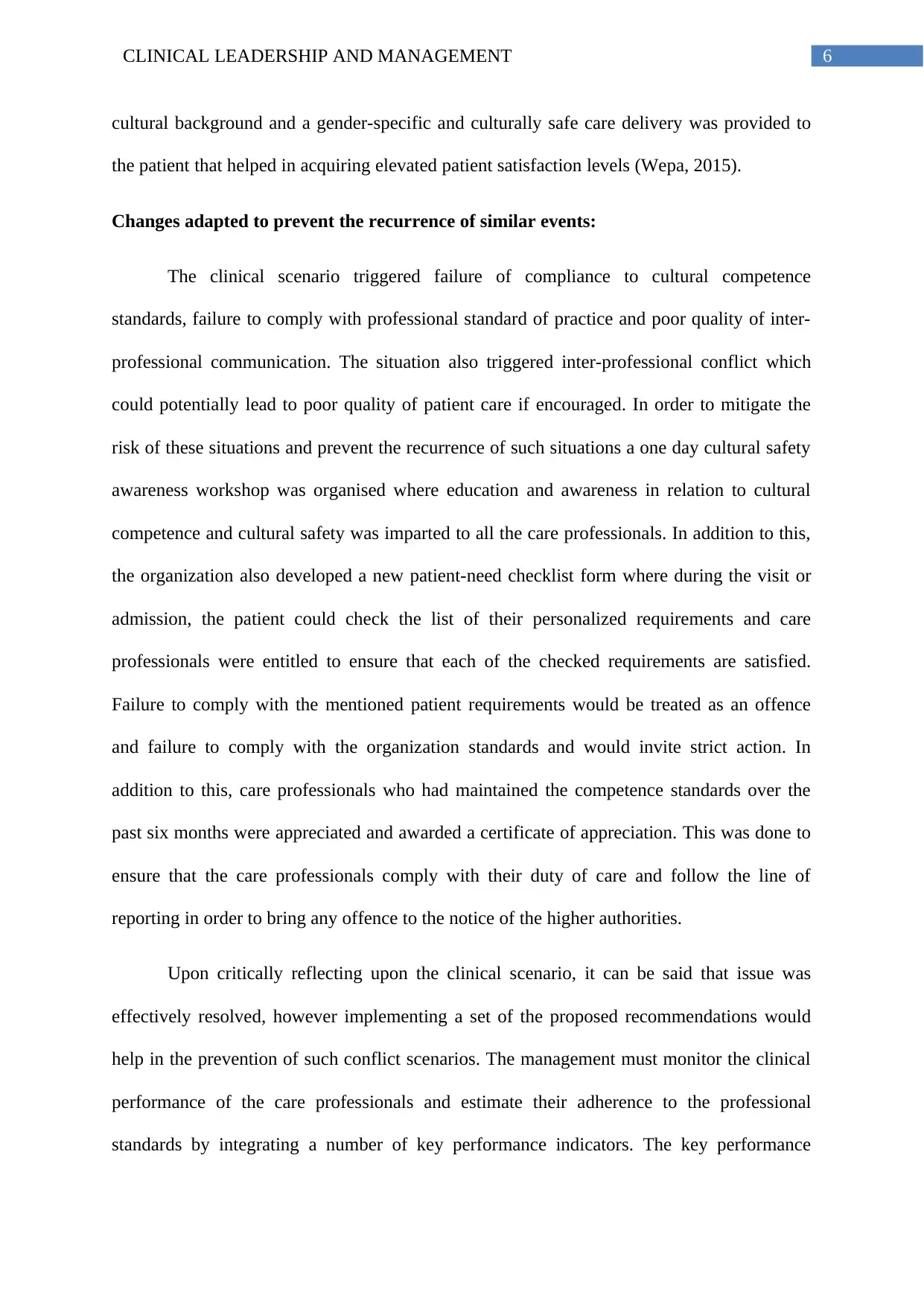
6CLINICAL LEADERSHIP AND MANAGEMENT
cultural background and a gender-specific and culturally safe care delivery was provided to
the patient that helped in acquiring elevated patient satisfaction levels (Wepa, 2015).
Changes adapted to prevent the recurrence of similar events:
The clinical scenario triggered failure of compliance to cultural competence
standards, failure to comply with professional standard of practice and poor quality of inter-
professional communication. The situation also triggered inter-professional conflict which
could potentially lead to poor quality of patient care if encouraged. In order to mitigate the
risk of these situations and prevent the recurrence of such situations a one day cultural safety
awareness workshop was organised where education and awareness in relation to cultural
competence and cultural safety was imparted to all the care professionals. In addition to this,
the organization also developed a new patient-need checklist form where during the visit or
admission, the patient could check the list of their personalized requirements and care
professionals were entitled to ensure that each of the checked requirements are satisfied.
Failure to comply with the mentioned patient requirements would be treated as an offence
and failure to comply with the organization standards and would invite strict action. In
addition to this, care professionals who had maintained the competence standards over the
past six months were appreciated and awarded a certificate of appreciation. This was done to
ensure that the care professionals comply with their duty of care and follow the line of
reporting in order to bring any offence to the notice of the higher authorities.
Upon critically reflecting upon the clinical scenario, it can be said that issue was
effectively resolved, however implementing a set of the proposed recommendations would
help in the prevention of such conflict scenarios. The management must monitor the clinical
performance of the care professionals and estimate their adherence to the professional
standards by integrating a number of key performance indicators. The key performance
cultural background and a gender-specific and culturally safe care delivery was provided to
the patient that helped in acquiring elevated patient satisfaction levels (Wepa, 2015).
Changes adapted to prevent the recurrence of similar events:
The clinical scenario triggered failure of compliance to cultural competence
standards, failure to comply with professional standard of practice and poor quality of inter-
professional communication. The situation also triggered inter-professional conflict which
could potentially lead to poor quality of patient care if encouraged. In order to mitigate the
risk of these situations and prevent the recurrence of such situations a one day cultural safety
awareness workshop was organised where education and awareness in relation to cultural
competence and cultural safety was imparted to all the care professionals. In addition to this,
the organization also developed a new patient-need checklist form where during the visit or
admission, the patient could check the list of their personalized requirements and care
professionals were entitled to ensure that each of the checked requirements are satisfied.
Failure to comply with the mentioned patient requirements would be treated as an offence
and failure to comply with the organization standards and would invite strict action. In
addition to this, care professionals who had maintained the competence standards over the
past six months were appreciated and awarded a certificate of appreciation. This was done to
ensure that the care professionals comply with their duty of care and follow the line of
reporting in order to bring any offence to the notice of the higher authorities.
Upon critically reflecting upon the clinical scenario, it can be said that issue was
effectively resolved, however implementing a set of the proposed recommendations would
help in the prevention of such conflict scenarios. The management must monitor the clinical
performance of the care professionals and estimate their adherence to the professional
standards by integrating a number of key performance indicators. The key performance
Paraphrase This Document
Need a fresh take? Get an instant paraphrase of this document with our AI Paraphraser
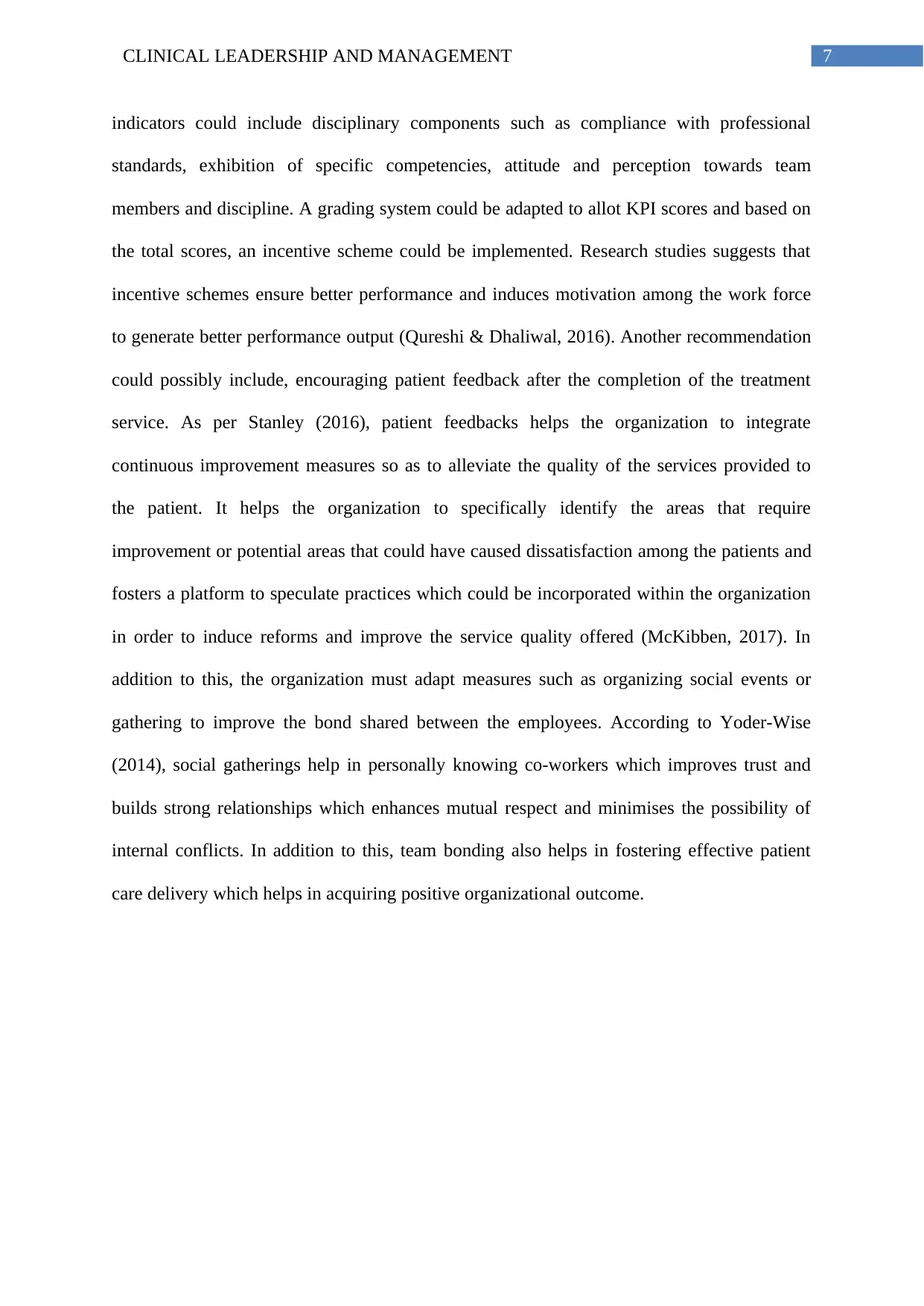
7CLINICAL LEADERSHIP AND MANAGEMENT
indicators could include disciplinary components such as compliance with professional
standards, exhibition of specific competencies, attitude and perception towards team
members and discipline. A grading system could be adapted to allot KPI scores and based on
the total scores, an incentive scheme could be implemented. Research studies suggests that
incentive schemes ensure better performance and induces motivation among the work force
to generate better performance output (Qureshi & Dhaliwal, 2016). Another recommendation
could possibly include, encouraging patient feedback after the completion of the treatment
service. As per Stanley (2016), patient feedbacks helps the organization to integrate
continuous improvement measures so as to alleviate the quality of the services provided to
the patient. It helps the organization to specifically identify the areas that require
improvement or potential areas that could have caused dissatisfaction among the patients and
fosters a platform to speculate practices which could be incorporated within the organization
in order to induce reforms and improve the service quality offered (McKibben, 2017). In
addition to this, the organization must adapt measures such as organizing social events or
gathering to improve the bond shared between the employees. According to Yoder-Wise
(2014), social gatherings help in personally knowing co-workers which improves trust and
builds strong relationships which enhances mutual respect and minimises the possibility of
internal conflicts. In addition to this, team bonding also helps in fostering effective patient
care delivery which helps in acquiring positive organizational outcome.
indicators could include disciplinary components such as compliance with professional
standards, exhibition of specific competencies, attitude and perception towards team
members and discipline. A grading system could be adapted to allot KPI scores and based on
the total scores, an incentive scheme could be implemented. Research studies suggests that
incentive schemes ensure better performance and induces motivation among the work force
to generate better performance output (Qureshi & Dhaliwal, 2016). Another recommendation
could possibly include, encouraging patient feedback after the completion of the treatment
service. As per Stanley (2016), patient feedbacks helps the organization to integrate
continuous improvement measures so as to alleviate the quality of the services provided to
the patient. It helps the organization to specifically identify the areas that require
improvement or potential areas that could have caused dissatisfaction among the patients and
fosters a platform to speculate practices which could be incorporated within the organization
in order to induce reforms and improve the service quality offered (McKibben, 2017). In
addition to this, the organization must adapt measures such as organizing social events or
gathering to improve the bond shared between the employees. According to Yoder-Wise
(2014), social gatherings help in personally knowing co-workers which improves trust and
builds strong relationships which enhances mutual respect and minimises the possibility of
internal conflicts. In addition to this, team bonding also helps in fostering effective patient
care delivery which helps in acquiring positive organizational outcome.
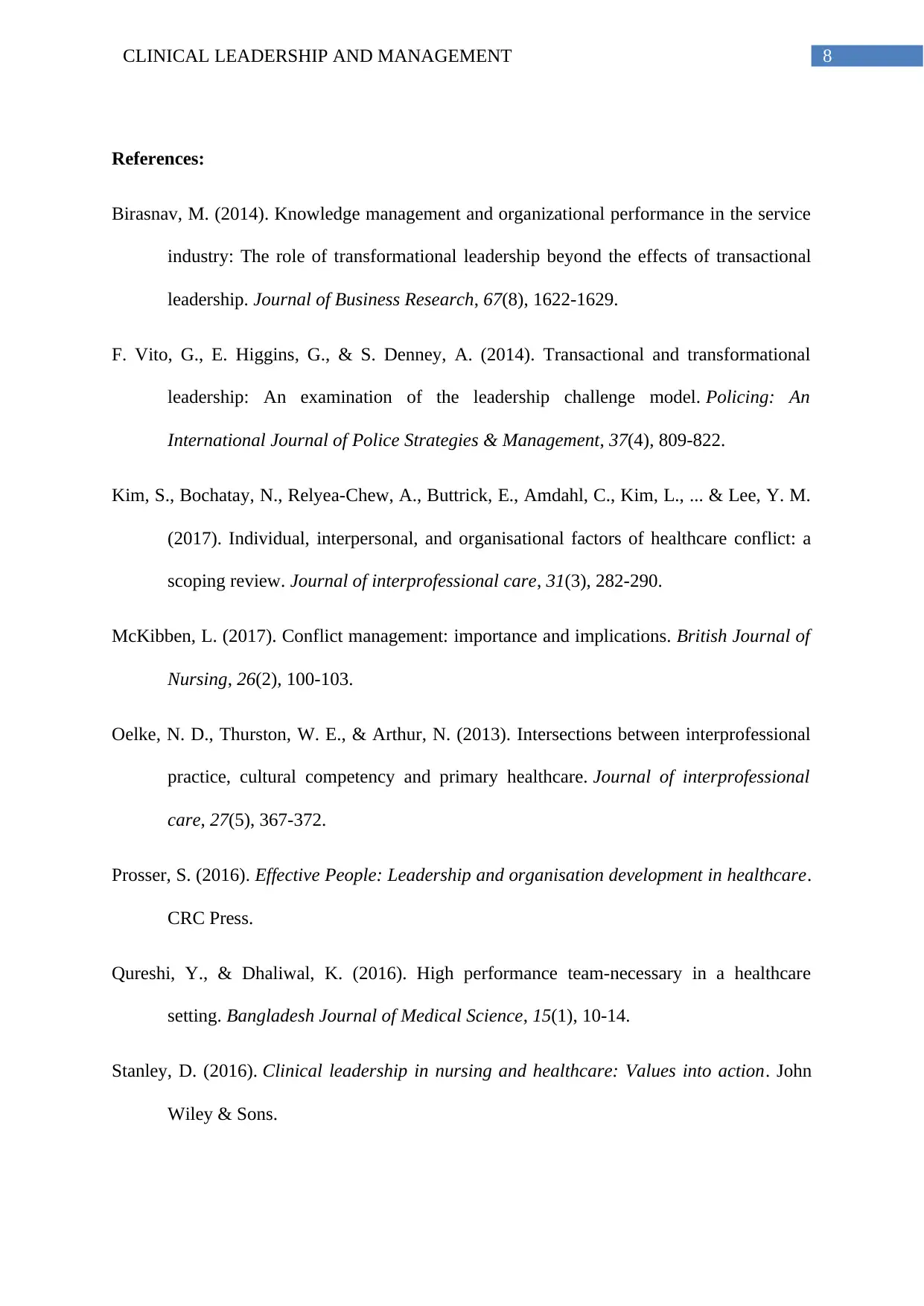
8CLINICAL LEADERSHIP AND MANAGEMENT
References:
Birasnav, M. (2014). Knowledge management and organizational performance in the service
industry: The role of transformational leadership beyond the effects of transactional
leadership. Journal of Business Research, 67(8), 1622-1629.
F. Vito, G., E. Higgins, G., & S. Denney, A. (2014). Transactional and transformational
leadership: An examination of the leadership challenge model. Policing: An
International Journal of Police Strategies & Management, 37(4), 809-822.
Kim, S., Bochatay, N., Relyea-Chew, A., Buttrick, E., Amdahl, C., Kim, L., ... & Lee, Y. M.
(2017). Individual, interpersonal, and organisational factors of healthcare conflict: a
scoping review. Journal of interprofessional care, 31(3), 282-290.
McKibben, L. (2017). Conflict management: importance and implications. British Journal of
Nursing, 26(2), 100-103.
Oelke, N. D., Thurston, W. E., & Arthur, N. (2013). Intersections between interprofessional
practice, cultural competency and primary healthcare. Journal of interprofessional
care, 27(5), 367-372.
Prosser, S. (2016). Effective People: Leadership and organisation development in healthcare.
CRC Press.
Qureshi, Y., & Dhaliwal, K. (2016). High performance team-necessary in a healthcare
setting. Bangladesh Journal of Medical Science, 15(1), 10-14.
Stanley, D. (2016). Clinical leadership in nursing and healthcare: Values into action. John
Wiley & Sons.
References:
Birasnav, M. (2014). Knowledge management and organizational performance in the service
industry: The role of transformational leadership beyond the effects of transactional
leadership. Journal of Business Research, 67(8), 1622-1629.
F. Vito, G., E. Higgins, G., & S. Denney, A. (2014). Transactional and transformational
leadership: An examination of the leadership challenge model. Policing: An
International Journal of Police Strategies & Management, 37(4), 809-822.
Kim, S., Bochatay, N., Relyea-Chew, A., Buttrick, E., Amdahl, C., Kim, L., ... & Lee, Y. M.
(2017). Individual, interpersonal, and organisational factors of healthcare conflict: a
scoping review. Journal of interprofessional care, 31(3), 282-290.
McKibben, L. (2017). Conflict management: importance and implications. British Journal of
Nursing, 26(2), 100-103.
Oelke, N. D., Thurston, W. E., & Arthur, N. (2013). Intersections between interprofessional
practice, cultural competency and primary healthcare. Journal of interprofessional
care, 27(5), 367-372.
Prosser, S. (2016). Effective People: Leadership and organisation development in healthcare.
CRC Press.
Qureshi, Y., & Dhaliwal, K. (2016). High performance team-necessary in a healthcare
setting. Bangladesh Journal of Medical Science, 15(1), 10-14.
Stanley, D. (2016). Clinical leadership in nursing and healthcare: Values into action. John
Wiley & Sons.
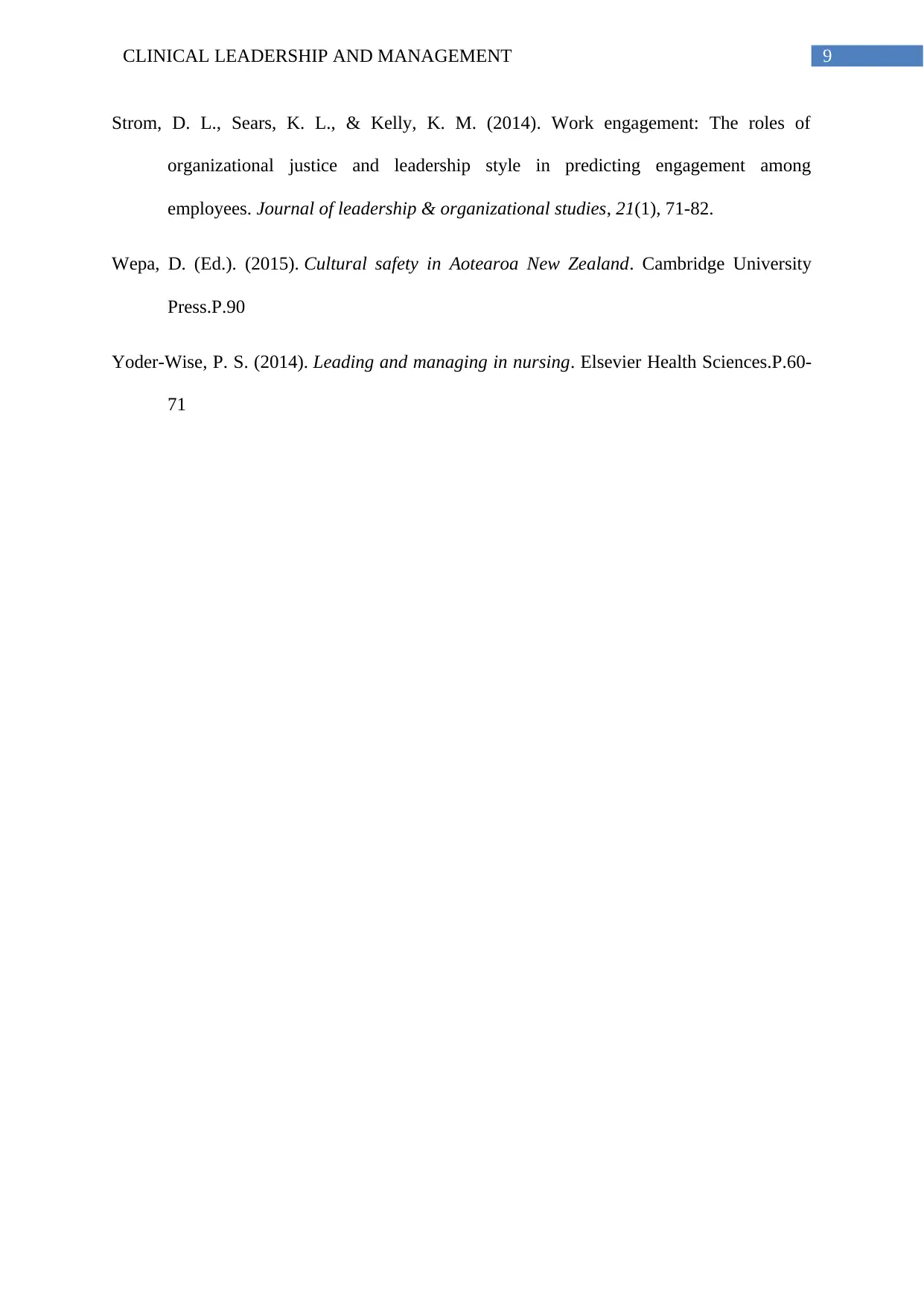
9CLINICAL LEADERSHIP AND MANAGEMENT
Strom, D. L., Sears, K. L., & Kelly, K. M. (2014). Work engagement: The roles of
organizational justice and leadership style in predicting engagement among
employees. Journal of leadership & organizational studies, 21(1), 71-82.
Wepa, D. (Ed.). (2015). Cultural safety in Aotearoa New Zealand. Cambridge University
Press.P.90
Yoder-Wise, P. S. (2014). Leading and managing in nursing. Elsevier Health Sciences.P.60-
71
Strom, D. L., Sears, K. L., & Kelly, K. M. (2014). Work engagement: The roles of
organizational justice and leadership style in predicting engagement among
employees. Journal of leadership & organizational studies, 21(1), 71-82.
Wepa, D. (Ed.). (2015). Cultural safety in Aotearoa New Zealand. Cambridge University
Press.P.90
Yoder-Wise, P. S. (2014). Leading and managing in nursing. Elsevier Health Sciences.P.60-
71
1 out of 10
Related Documents
Your All-in-One AI-Powered Toolkit for Academic Success.
+13062052269
info@desklib.com
Available 24*7 on WhatsApp / Email
![[object Object]](/_next/static/media/star-bottom.7253800d.svg)
Unlock your academic potential
© 2024 | Zucol Services PVT LTD | All rights reserved.





